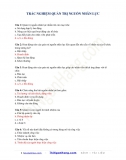ĐỀ THI ANH VĂN MOODY VÀO VIETCOMBANK - ĐỀ SỐ 2
Đề thi tương tự English Test cho các vị trí
Tín dụng, Phê duyệt tín dụng, Kiểm soát nội bộ Vietcombank
(Xem Đáp án từ Trang 5)
1. A business usually has a strong need for financing but represents too much risk to the bank as it progresses through which stage of its life cycle.
A. Start-up
B. Adolescence
C. Maturity
D. Decline
2. A business that generally sells a major portion of its product to one buyer has leverage in that it can then dictate the terms of the relationship with the purchaser.
A. True
B. False
3. A profitable business requires a considerable level of financing to entirely support increasing levels of operating expenses when in a growth phase.
A. True
B. False
4. A business usually has the smallest need for financing as it progresses through which stage of its life cycle.
A. Start-up
B. Growth
C. Maturity
D. Decline
5. A business usually has the greatest need for financing as it progresses through which stage of its life cycle.
A. Adolescence
B. Growth
C. Maturity
D. Transformation
6. As a stage in the life cycle of an industry or business, "maturity" refers to ________________ .
A. when market demand has exceeded the available supply and sales and profits grow very rapidly.
B. a fundamental change in the operations of a business intended to try and stave off demise.
C. products remaining widely accepted and in high demand, and the capacity of the market growing as new competitors enter the marketplace.
D. the set of activities that accompany sales shifts from expansion to contraction.
E. the life cycle stage in which a business is successfully dissolved.
7. As a stage in the life cycle of an industry or business, "adolescence" refers to ________________ .
A. the set of activities that accompany sales shifts from expansion to contraction
B. when the product being sold has achieved a degree of acceptance and sales levels begin to increase
C. products remaining widely accepted and in high demand, the capacity of the market has grown as new competitors enter the marketplace
D. when market demand has exceeded the available supply and sales and profits grow very rapidly
E. the life cycle stage in which a business is successfully dissolved
8. As a stage in the life cycle of an industry or business, "transition" refers to ________________ .
A. any movement from one life cycle stage to the next
B. the life cycle stage in which a business is successfully dissolved
C. when the product being sold has achieved a degree of acceptance and sales levels begin to increase
D. a fundamental change in the operations of a mature business intended to try and stave off demise.
E. the set of activities that accompany sales shifts from expansion to contraction
9. Credit risk varies depending on the stage of an industry's life cycle. Emerging and declining industries generally carry more risk, while growing and mature industries are less risky.
A. True
B. False
10. Credit risk varies depending on the stage of an industry's life cycle. Emerging and declining industries generally carry less risk, while growing and mature industries are more risky.
A. True
B. False
11. During a period of economic contraction as sales begin to decline, receivables (trade debtors) and inventory (stock) levels tend to decrease and capital spending slows or stops.
A. True
B. False
12. During a period of economic contraction as sales begin to decline, receivables (trade debtors), inventory (stock) and capital spending levels tend to rise.
A. True
B. False
13. During a growth phase, a profitable business requires a greater level of financing solely to support increasing levels of receivables (trade debtors) and inventory (stock).
A. True
B. False
14. Integrity is a critical management characteristic because it is the single best indicator of success for a business.
A. True
B. False
15. Integrity is a critical management characteristic because ________________ .
A. the lender's relationship is with management, not with the business.
B. it is the single most important indicator of a company's repayment ability.
most of the information needed to properly assess credit risk is provided by management.


 ThiNganHang Sách - Tài liệu thi tuyển
ThiNganHang Sách - Tài liệu thi tuyển









